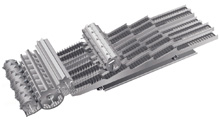
Features
Agronomy
Corn
Research looks at silage corn row spacing and plant populations
As hybrid corn silage continues to displace barley...
December 18, 2007 By Bruce Barker
As hybrid corn silage continues to displace barley as a preferred feedlot crop, corn producers have had to rely on agronomic recommendations from Ontario and the US. Now, part way through a three year study, researchers at Agriculture and Agri-Food Canada (AAFC) are looking at whether those recommendations make sense for southern Alberta.
 Figure 1. Response of hybrid corn to seeding rate and row spacing: 2005 data. Source: Beres, AAFC Lethbridge.
Figure 1. Response of hybrid corn to seeding rate and row spacing: 2005 data. Source: Beres, AAFC Lethbridge.
“Hybrid corn silage production is a relatively young practice in southern Alberta, and producers have had to experiment on a field scale basis to try to figure out the best row spacing and seeding rates,” explains Brian Beres, a cereal agronomist with the AAFC Lethbridge Research Centre. He is conducting the research with Corny van Dasselaar of BenchMark Seeds in Lethbridge. “We’re trying to answer the question as to how farmers can optimize silage yield and quality with their corn seeding system?”
The three year research project started in 2005 and was developed to assess corn silage yields when planted in 15 inch and 30 inch row spacing, and at five different seeding rates, ranging from 26,000 kernels per acre all the way up to 46,000 kernels per acre. A John Deere 71 Flexi-Planter (plates) was used to plant the Roundup Ready Pioneer 39K39 corn hybrid (2600CHU).
The first year of research found that the 15 inch row spacing at 34,000 kernels per acre provided the highest yields at 6.24 tons per acre. The 30 inch row spacing required a seeding rate of 38,000 kernels per acre to achieve the maximum attainable yield but even at that higher density seeding, produced a lower silage yield (5.75 tons per acre) than the 15 inch row spacing.
The second year of research, in 2006, saw a similar trend, although the differences between treatments were not as dramatic and yields did not appear to be significantly different. Beres explains there were issues with flooding and a light hail storm in 2006 that made the data less reliable.
 Beres says the narrow row system should, theoretically, be more efficient in terms of resource utilization, although he was surprised at the degree to which its yield exceeded the wide row spacing in 2005. The higher silage yield with the narrow row spacing was also with lower plant populations.
Beres says the narrow row system should, theoretically, be more efficient in terms of resource utilization, although he was surprised at the degree to which its yield exceeded the wide row spacing in 2005. The higher silage yield with the narrow row spacing was also with lower plant populations.
Initial research shows silage yield would benefit from higher plant population. Photo By Bruce Barker.
The final year of the research ran in 2007. If the trend continues, Beres explains there could be several implications for corn growers. The narrow row spacing could allow producers to reduce plant populations compared to a wide row spacing, which would help to offset seed input costs without compromising silage yield.
However, a common seeding rate currently used is 28,000 kernels per acre, which may not be enough for either the 15 inch or 30 inch row spacing. As a result, producers may want to consider increasing their planting densities.
To help offset the increased seed costs should the trend persist at the end of the three year study, producers could consider moving from wider row spacing to narrower spacing.
“With the narrower row spacing, we could be seeing better resource utilization and improved weed competition by the corn plants,” explains Beres, who is also analyzing quality parameters in the 2006 data. He hopes to have the final results of the research sometime in early 2008.